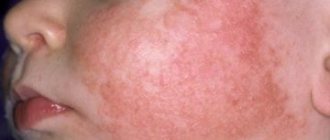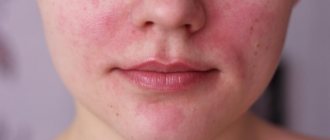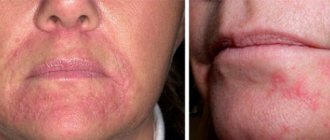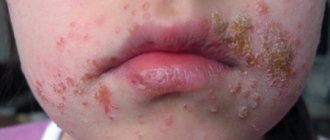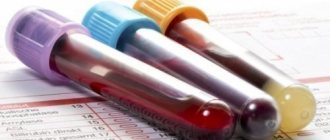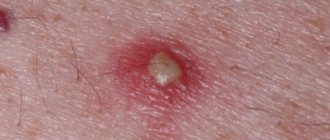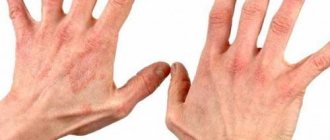- June 22, 2018
- Dermatology
- Nadezhda Devlyashova
A disease characterized by irritation on the face and/or inflammation of the skin is called dermatitis. Due to all kinds of irritants, a general or local reaction occurs on the skin. Depending on the symptoms and causes of the disease, several types of the disease are distinguished, including atopic dermatitis on the face.
If in the middle of the last century it was mainly children who were susceptible to dermatitis, now adults often suffer from this disease. Most often, dermatitis occurs in women, as their skin is more sensitive. The disease manifests itself as unsightly red spots, irritating unpleasant itching, and constant discomfort. In addition to unpleasant symptoms, atopic dermatitis leads to deterioration in appearance, low self-esteem and a complete reluctance to appear in public.
Causes of the disease
The most common causes of atopic dermatitis on the face are the following:
- Failure of the functioning of the endocrine glands, which is detected during testing.
- Cosmetics that are unsuitable for your skin type, or low quality care products that have expired.
- Heredity, genetic factor. If close relatives suffer from this disease, it may also affect you. In this case, it is necessary to take preventive measures.
- Hormonal imbalances in the body.
- Dry indoor air. Rare walks in the fresh air can provoke the manifestation of symptoms of the disease.
- Bad habits, alcohol, smoking, poor diet can cause atopic dermatitis.
- Insomnia, severe stress.
A photo of atopic dermatitis on the face indicates manifestations of the disease. If you notice such signs in yourself, you should pay attention to your health, lifestyle, and consult a doctor.
Sun allergy: what is it?
There is no need to think that the allergen that causes inflammation is the sun's rays themselves. The mechanism of the disease is somewhat more complicated. Increased susceptibility to ultraviolet radiation is caused by the presence in the patient’s body of sun-sensitive substances - photosensitizers. The interaction of their radicals with skin protein leads to inflammation.
In addition, not only solar dermatitis occurs, but also a violent reaction of the body to artificial tanning. By the way, frequent visits to the solarium can provoke an allergy to the sun's rays.
Symptoms of atopic dermatitis on the face
Dermatitis can be subacute, acute and chronic. Each has its own characteristic symptoms. Subacute form:
- formation of scales and scabs on the skin;
- severe itching is felt and red spots appear.
In acute form:
- swelling, inflammation is pronounced, this is clearly visible in the photo of atopic dermatitis on the face;
- pain, facial skin is painful to touch, sensitivity increases;
- itching, burning;
- Blisters and areas of necrosis may appear.
Photos of atopic dermatitis in children on the face:
If the disease becomes chronic, longer and more complex exposure is required. Symptoms:
- the face becomes covered with inflammatory lesions;
- the rash appears in the cheeks, nose, forehead, mouth;
- the skin peels, severe itching, and watery blisters appear;
- sensitivity worsens until pain occurs;
- There may be pain in the joints, in the head, and an increase in temperature;
- the skin becomes thinner, becomes dry, and resembles parchment.
Dermatitis develops very quickly. If similar symptoms begin to bother you (photos of atopic dermatitis on the face), treatment should begin immediately. This will prevent the disease from developing into more severe forms.
Symptoms
The initial stage of the disease in adults and children is redness of the skin of varying intensity. The spots cover the forehead, cheeks, nasolabial area and eyelids.
In adults
Allergic dermatitis in adults begins with increased skin sensitivity . The patient feels pain when touching his face.
Subsequently, the following symptoms develop on the skin:
- keratinization of individual areas;
- bluish skin;
- swelling, flowing into puffiness of the oval of the face;
- headache;
- feverish conditions;
- eczema when scratching the affected areas.
With constant contact of the body with allergens, complications develop:
- rhinitis;
- lacrimation;
- conjunctivitis.
Video about the causes, symptoms and treatment of allergic dermatitis in adults
Candidate of Medical Sciences, dermatologist, cosmetologist Daria Konstantinovna Dombrovskaya talks about allergic dermatitis in adults.
In children
Allergic dermatitis in a child begins with redness of the cheeks , called diathesis by parents. Gradually, the spots spread to the area of the head, ears, and neck.
Small papules with clear liquid inside appear on the reddened areas.
If contact with the allergen continues, the rash extends beyond the head area and covers almost the entire body. The child becomes irritable, refuses to eat, and sleeps poorly.
Stages of development of dermatitis
During the development of an allergic reaction, the disease goes through 3 stages:
- Spicy . Small red spots with clear contours appear, then small bubbles form on them. The skin reacts sharply to mechanical stress.
- Subacute . The reddened areas begin to peel off. General malaise appears. Gradually, the peeling turns into scars.
- Chronic . The disease is characterized by periodic exacerbations and subsidence. Exacerbations are most often seasonal. With each exacerbation, the number of spots increases.
Atopic dermatitis on the face. Treatment
Atopic dermatitis (eczema) develops from allergic dermatitis, but its form is more advanced, and it is much less treatable. On the face, eczema is chronic.
Atopic dermatitis on the face cannot be treated with one drug. Skin inflammatory processes are a consequence of many negative reactions of the body that affect various systems. Before prescribing treatment, the doctor, using tests, provocative, intradermal tests, finds out the etiology of the disease, the reasons why the inflammatory processes occurred. Only then is adequate treatment prescribed, including a number of different drugs.
Atopic dermatitis takes a long time to treat, which can take months. That is why it is recommended to treat the allergic type of dermatitis in a timely manner.
Diseased areas of the skin become too vulnerable, inflammation progresses, and the skin becomes rougher. Causative agents of various infections easily settle on open wounds, making treatment more complicated. The following series of drugs are usually prescribed:
- Antidepressants, sedatives (infusions of motherwort, valerian, Novopassit, Persen).
- Individual or complex vitamin therapy, pyridoxine is prescribed.
- Antihistamines.
- Immunomodulators.
- Ointments, creams for dermatitis (hormonal or non-hormonal).
- In advanced cases, hormone therapy is performed.
Atopic dermatitis in children on the face is treated taking into account the form of the disease, stage, and period. It is important to take into account the age of the child, as well as the area of the affected skin. The products differ in: systemic action (used in combination) and external use.
Diagnostics
To confirm the diagnosis of photodermatosis, an allergist or dermatologist does not have enough information about the symptoms. The diagnostic process must necessarily take an integrated approach.
Diagnostics includes the following activities:
- familiarization with the medical history - to identify the internal causes of the development of the disease;
- collection and analysis of life history - to establish an external provoking factor;
- thorough examination of the condition of the skin;
- palpation of the affected skin area;
- detailed survey;
- general clinical and biochemical blood tests;
- general urine analysis, Zimnitsky test;
- hormonal tests;
- skin biopsy;
- specific photographic tests;
- radiography;
- ultrasonography;
- CT;
- MRI.
Skin biopsy
Polymorphic photodermatosis, like other types of pathology, should be differentiated from the following diseases:
- systemic lupus erythematosus;
- sunburn;
- lichen planus;
- erysipelas;
- radiation, atopic, contact and allergic dermatitis.
Antihistamines
Atopic dermatitis on the face in adults is treated with the mandatory use of antihistamines. Most often, the doctor recommends:
- "Elokom". Helps relieve swelling and has an antipruritic effect.
- "Trickzera". Helps reduce facial skin sensitivity.
- "Afloderm". The product is used for three weeks. Relieves swelling, itching, reduces inflammation.
- "Solcoseryl". Has a healing effect.
At the same time, doctors recommend the use of drugs to maintain the proper functioning of the gastrointestinal tract, as well as drugs to stabilize a person’s emotional state.
Vitamins for seborrheic dermatitis: which ones are missing?
In many cases of dermatitis, especially with atopic and seborrheic types, food is a direct trigger for the onset and progression of the disease. Identifying foods that negatively affect the body will help you find a solution to cure dermatitis.
In order to completely get rid of the disease, it is enough to nourish the body with useful vitamins that have a beneficial effect on the development of skin, hair, nails and the body as a whole.
In this article we will look at which vitamins are useful for seborrheic scalp and which vitamins are beneficial for seborrheic dermatitis of the face.
Examples of seborrheic dermatitis on the scalp and seborrheic dermatitis on the face are shown below:
Examples of seborrheic dermatitis on the head and face
What vitamins are missing in seborrheic dermatitis? List of vitamins that the body lacks with seborrhea How to compensate for the lack of vitamins with seborrheic dermatitis? Nutrition or diet for seborrheic dermatitis List of drugs to replenish vitamins
What vitamins are missing in seborrheic dermatitis?
Did you know that dandruff and an increase in subcutaneous sebum occur due to a lack of vitamins? Due to a lack of vitamins, the body cannot recover and gain energy. When there are enough vitamins, the body will be able to cope with all ailments on its own. However, what vitamins have a beneficial effect on the body for seborrheic dermatitis?
First of all, let's determine which vitamins and elements are lacking that leads to dandruff, dry skin, itching and seborrheic dermatitis?
- Vitamin A;
- B vitamins (1,2,3,5,6,8, 9,12);
- Vitan S;
- Vitamin D;
- Vitamin E;
- Vitamin F;
- Vitamin H;
- Vitamin PP;
- Selenium;
- Sulfur;
- Magnesium;
- Copper;
- Zinc;
- Phosphorus;
List of vitamins that the body lacks with seborrhea
Let's look at what vitamins need to be kept in balance for seborrheic dermatitis:
- Foods Rich in Vitamin A:
Vitamin A helps keep your skin in good condition. It also does an excellent job of treating such types of ailments as: acne, dry skin, oily skin, herpes, eczema, psoriasis, swelling. Products that contain this vitamin help get rid of dandruff, strengthen hair and help it grow. Vitamin A is found in plant foods (carotenoids): carrots, chard, spinach, watercress, borage, pumpkin, tomatoes, dandelions, peppers, watermelon, Brussels sprouts, banana, apple, plum, legumes. Vitamin A deficiency leads to dry, flaky skin and poor dental health. - Food rich in B vitamins:
Food rich in B vitamins, especially biotin (vitamin B7), normalizes the nervous and cardiovascular system, soothes the functioning of the intestines and skin, helps cope with stress and strengthens the immune system. It is the components that are found in vitamin B that are responsible for the condition of hair and nails; they also remove oiliness that accumulates with seborrheic dermatitis. Vitamins of this group should be included in the daily diet. It should be noted that during heat treatment these vitamins are lost and do not bring the benefits that are necessary for the restoration of skin and hair. Foods rich in vitamin B include all grains (rice, wheat, oats), legumes (soybeans, peas, lentils, beans), and nuts. Vitamin B deficiency leads to constant fatigue (which can develop into chronic fatigue), dry, pale skin and dermatitis. - Foods rich in vitamin C:
Vitamin is an active antioxidant that helps prevent and improve skin condition with psoriasis, eczema and dermatitis; Vitamin C is involved in the formation of collagen. It also improves the immune system, accelerates the healing process of wounds, and normalizes bleeding processes (to prevent blood clots from forming). Vitamin C can be found in almost all fruits and vegetables. It is found in cabbage, paprika, parsley, lemons, black currants, rose hips, chili peppers, kiwi, mangoes and other vegetables and fruits. A lack of vitamin C leads to decreased immunity and frequent colds, as well as disruption of collagen and restoration of skin cells. - Foods rich in vitamin D:
Vitamins of this group enter the body through external influences or through food. Vitamin D ensures the body's absorption of phosphorus and calcium from food, regulates immune responses and is responsible for hair growth. Vitamin D3 is usually formed under the skin when exposed to sunlight. Vitamin D enters the body through sun rays and food. It is found in fatty fish (tuna, cod, salmon), eggs and butter. A lack of vitamin leads to depression and depression, muscle weakness and even polycystic ovary syndrome. In winter, you can replenish vitamin reserves by walking during the day (especially if there is sun), drinking fish oil or taking a multivitamin complex, which also includes vitamin D. - Foods Rich in Vitamin E:
Vitamin E is considered an important element that helps with skin repair. Vitamin elements help cells regenerate, maintain normal hemoglobin levels, and replenish the reproductive organs with the necessary components. It helps cells prevent the oxidation of bad cholesterol. The best sources of vitamin E are various types of oils: sunflower, flaxseed, olive; seeds, nuts, almonds, whole grain bread, whole grain sprouts, paprika, avocado, liver. Vitamin deficiency leads to neuropathy and problems with the functioning of blood vessels. - Foods rich in vitamin F:
Vitamin F is also called the vitamin of youth. It maintains skin structure, moisturizes it and maintains a healthy glow. The best sources of vitamin F are flax seeds, sunflower seeds, pumpkin seeds, vegetable oils, soybeans, peanuts, walnuts, corn, fish (salmon, mackerel, trout, tuna), shellfish, currants, eggs. For better absorption of vitamin F and its long-term preservation in the body, it is better to take it in combination with vitamin E, B6 and C. With a deficiency of vitamin F, there is a feeling of constant fatigue, fatigue, dry skin, skin problems, gastrointestinal disorders, menstrual irregularities in women, infertility in men. - Foods rich in vitamin H: Vitamins of this group do an excellent job of protecting and restoring hair, and also help accelerate its growth. They regulate the process of amino acid metabolism. Traditional sources of the vitamin are legumes (soybeans, peas, chickpeas), yeast, eggs, and liver. With vitamin deficiency, dermatitis occurs, dry skin of the whole body, lethargy, drowsiness, and loss of appetite are observed.
- Foods rich in vitamin PP:
The vitamin is involved in the synthesis of enzymes and stabilizes cellular respiration of the skin. Contained in almost all dairy products, fish, liver, tomatoes, potatoes, carrots, dates, broccoli. With a lack of vitamins of this group, the skin becomes dry and pale, the lips acquire a blue or purple tint.
- Selenium: Is an important element for the functioning of the thyroid gland. It is found in Brazil nuts, cashews, macadamia; tuna, mackerel, oysters, mussels, shrimp, clams; brown rice, quinoa, pearl barley; chia, flax, sunflower seeds; cottage cheese, eggs, whole grain pasta. Selenium acts as an antioxidant and promotes the functioning of the immune system. If there is a lack of it in the body, the growth of hair and nails is disrupted, the functioning of the immune system decreases, and the skin dries out.
- Sulfur:
Helps melanin protect skin from UV rays. Sulfur is found in turkey meat, pork, beef, liver, flounder, pike, sea bass, sardines, peas, and eggs. Excess sulfur in the body leads to sagging skin, the appearance of rashes, redness, and itching; nails become thin, hair loses its shine, becomes dry and brittle. - Magnesium:
The vitamin takes part in the development of the female reproductive system. It is needed to absorb calcium and strengthen bones, hair, and nails. Magnesium is found in: wheat bran, cocoa, cashews, peanuts, buckwheat, soybeans, almonds, brown rice, spinach, asparagus, dried dates, chicken eggs. A lack of magnesium in the body leads to depressed mood, premature aging, loss of skin tone, stretch marks, deterioration of nails and hair; the metabolic rate decreases, the constant feeling of stress increases, and stress, as we already know, leads to seborrheic dermatitis. - Copper: Protects collagen from destruction, participates in skin restoration. Copper is found in rose hips, shiitake mushrooms, sun-dried tomatoes, Brazil nuts, cocoa powder, lobster, squid, lamb, beef and pork liver. Excess copper leads to early gray hair, increased susceptibility to allergic dermatoses, and vitiligo may occur.
- Zinc:
This element is actively involved in immunogenesis, in the storage of insulin in pancreatic cells, and ensures cell growth and division. Takes part in wound healing and DNA formation. Zinc is contained in seeds, wheat grains, cabbage, spinach, onions, watercress, lentils, beans, mushrooms, nuts, and meat. With a lack of zinc, the digestive process and skin condition worsen, and wound healing slows down. - Phosphorus: A trace element necessary for the functioning of the kidneys, liver, heart and brain. It also has a beneficial effect on the condition of teeth and joints, and regulates hormone levels. Phosphorus is found in seeds (sunflower, chia, flax), nuts (pistachios, almonds), fish and seafood (salmon, tuna, carp, mackerel, cod, oysters, mussels, shrimp), pork, cheeses (parmesan, mozzarella, goat cheese, gouda), legumes and soy products. A lack of phosphorus can lead to weakened bones, numbness, increased anxiety, delayed growth and development, and impaired skin metabolism.
- Food rich in proteins:
Food rich in proteins speeds up metabolism, proteins are involved in the process of formation of body tissues. Legumes and nuts are rich in proteins. Light meats include turkey, rabbit and lamb. The lack of foods containing protein in the diet leads to the appearance of seborrheic dermatitis.
How to compensate for the lack of vitamins with seborrheic dermatitis?
So you have read the list of elements and vitamins that are very important in the treatment of seborrheic dermatitis.
Follow proper nutrition, create a weekly diet and include foods with vitamins necessary for the treatment of seborrheic dermatitis on the head and face. Lack of vitamins in seborrhea of the scalp is easy to track.
Dizziness, a state of chronic lack of sleep, dryness and flaking of the skin are observed, and muscle pain may occur.
In order to get rid of these symptoms and help the body replenish its supply of vitamins, it is necessary to include vitamins in the diet.
Eat fruits and vegetables that are available in season: persimmons, apples and leafy greens are available annually; You can grow greens on your windowsill. Make up for the lack of fresh fruits with dried ones: dried apricots, figs, dates, prunes, raisins.
Prepare more cereals: dark rice, bulgur, buckwheat, lentils are rich in vitamin B and iron. Watch your diet; healthy vitamins and microelements must be absorbed.
Nutrition or diet for seborrheic dermatitis
Nutrition is very important to maintain a healthy body. Nutritional tips for seborrheic dermatitis include a healthy way of eating. In the previous article, we indicated how to properly cook for seborrheic dermatitis and provided an approximate menu for the week for children and adults.
Corticosteroids
Treatment of atopic dermatitis on the face in adults during the acute period includes, in addition to antihistamines, corticosteroids (hormones). Their influence extends to the foci of inflammation, thereby making the course of the disease significantly easier.
Atopic dermatitis on the face in adults, photo:
"Betamethasone." It has an effective effect at any stage of inflammation by reducing the concentration of lysosomal enzyme. Anti-allergenic and antipruritic effect. Relieves swelling due to improved microcirculation of interstitial fluid.
"Dexamethasone." The drug has a wide spectrum of action and is used in the treatment of all forms of dermatitis. Has antipruritic, anti-edematous, anti-inflammatory effect. It is worth noting that it has many side effects, so it can only be used under the supervision of a doctor.
"Prednisolone." It influences various types of metabolism in the human body. Has anti-allergic and anti-inflammatory effects. Helps with allergic, atopic, seborrheic dermatitis. Removes swelling, itching, inflammation. It has side effects and should be used only on the recommendation of a doctor.
Sun allergy in children
Photodermatitis develops quite often in children. This is due to not yet established immunity and rather thin skin. The main reasons include:
- Genetic conditioning. Children with fair skin and hair are usually affected by this disease.
- Taking medications.
- Failures in metabolic processes or developmental pathology.
- Worm infestation.
- Previous illness and deterioration of immunity.
- Provoking factors in the form of sun, sea water and food additives.
- Exposing a child to the sun during periods of high solar activity.
- Sharp changes in climatic zones.
- Having another type of allergic reaction.
Ointments and creams
One of the effective ways to treat atopic dermatitis on the face is the use of ointments and creams. They are divided into two large groups: non-hormonal agents and hormonal ones.
If the form of the disease is not advanced or severe, the doctor prescribes non-hormonal medications. They have a high therapeutic effect, while at the same time they have fewer side effects.
"Eplan". Used for various types of dermatitis, including atopic dermatitis on the face in adults. Has an antihistamine, anti-inflammatory effect, accelerates skin regeneration.
"Exoderil". Has an antifungal effect, reduces itching and inflammation.
"Gistan". Antiallergic drug. Visually reduces the manifestations of dermatitis, relieves swelling, itching, protects and moisturizes the skin.
"Radevit." Used to treat all types of dermatitis. Has antihistamine, decongestant and anti-inflammatory effect. The ointment contains extracts of medicinal plants.
"Losterine." The composition includes D-panthenol, plant extracts, natural oils. The effect on the skin is multifaceted: decongestant, antipruritic, antiallergic effect.
"Isis." The ointment has an antiseptic effect and prevents the development of inflammation. Contains herbal extracts and antiseptic. The ointment supports the skin's resistance and resistance to adverse factors.
"Topicrem". Face cream for atopic dermatitis, also useful for any irritation. Has a stimulating, regenerating, anti-inflammatory effect. Effective for dry, sensitive skin prone to various rashes, acne, redness. The protective film eliminates the feeling of tightness and maintains normal water balance. Contains: lactic acid, beeswax. Does not cause allergies, does not have a comedogenic effect, therefore suitable for use by children and adolescents.
Hormonal drugs are used as prescribed by a doctor. They are used for more severe forms of dermatitis.
Akriderm. Suitable for all types of dermatitis. It has anti-inflammatory and antipruritic effects, reduces redness, swelling, and peeling.
"Flucinar." Dries out areas of inflammation, reduces redness and swelling. The hormones included in the composition are not indicated for use during pregnancy and in children under two years of age.
"Celestoderm". Actively affects all types of dermatitis. Reduces the inflammatory process, relieves itching, swelling, and has antihistamine properties.
It is important to remember that hormonal drugs have many side effects, using them on your own is dangerous and can lead to various health problems. Use these products only under the supervision of a doctor.
Restoring healthy skin
After the main stage of treatment is completed, care should be taken to bring the appearance of the skin in order. Of course, the selection of cosmetics should be approached with special attention. La-Cri products are perfect for this purpose. Soft and gentle creams, emulsions and lotions are fragrance-free and hypoallergenic, so they will not cause irritation even on the most sensitive skin.
Skin reactions that are triggered by excessive sensitivity to sunlight, accompanied by excessive redness and skin rashes, are called photodermatitis in medical practice. It appears in humans after being exposed to direct sunlight. Every 5th person is subject to this influence. Global warming and increased solar activity are contributing to an increase in cases of adverse reactions to sunlight.

Antibiotics
In some cases, specialists, along with antihistamines and ointments, prescribe antibiotics for atopic dermatitis on the face. They help to successfully reduce inflammation. Most often these are:
- "Tetracycline".
- "Doxycycline."
- "Minocycline."
In some cases, in the first days of using antibiotics, the condition worsens. But after a course of treatment (from 10 to 14 days), a positive effect occurs, the condition of the skin improves, and inflammation goes away.
Types and photos of photodermatitis
Three types of response of human skin to ultraviolet rays of natural and artificial origin can be noted:
- Phototraumatic reactions. These are inflammations not associated with allergies. In other words, these are burns that appear from prolonged exposure to the sun or in a solarium booth. Anyone can have a similar reaction.
- Phototoxic reactions. This is a reaction to rays provoked by the consumption of foods containing photosensitizers. This type of allergy can occur even in a healthy person.
- Photoallergic reactions. They arise as a result of pathological rejection of sunlight by the body. Such a reaction is precisely a typical manifestation of a disease such as photodermatosis.
Normalization of intestinal microflora
Often, dermatitis that appears on the face is accompanied by problems that arise in the gastrointestinal tract. The functioning of the intestines is disrupted, the absorption of nutrients is reduced, and dysbiosis occurs. To eliminate this problem, along with other remedies, drugs that restore intestinal function are prescribed in combination.
"Acipol" helps eliminate digestive disorders, even those that have been going on for a long time. The drug is able to stimulate the immune system and increase the body's resistance to harmful factors. This is especially important for chronic forms of dermatitis. "Acipol" treats intestinal and eating disorders. There are no contraindications for use and no side effects.
"Hilak Forte". The drug contains synthetic lactic acid. It restores the acidity of the stomach and accelerates the development of normal symbionts in the intestines. In a short time, the intestinal microflora is normalized, pathogenic flora is reduced, and digestion is improved.
"Lysozyme". This is a probiotic that restores the correct intestinal microflora. It has an anti-inflammatory effect, negatively affects pathogenic microflora, and helps in the absorption of nutrients.
How does photodermatitis manifest?
Many of us are looking forward to summer. At this time, even a regular weekend spent in nature can feel like a mini-vacation.
However, the appearance of blisters on the neck, shoulders, back or wrists can greatly spoil the impression of your holiday and make you change your attitude towards the warm season.
A patient with solar urticaria who suffers from an allergy to sunlight can easily identify photodermatosis and its symptoms. The disease appears almost immediately after exposure to UV light on the skin.
A rash appears on the affected areas .
They can cause severe itching and discomfort, and in some cases the bumps merge into one large spot.
Sometimes manifestations of the disease appear much later, several days after the patient has been in the sun.
Reference ! Light urticaria is caused by the body's reaction to exposure to ultraviolet light. However, this disease is not a consequence of allergies in the classical sense of the word.
Device therapy methods
Treatment of atopic dermatitis on the face, in addition to the listed methods, also includes exposure to devices.
Ultraphonophoresis. The impact on the foci of the disease is carried out inside the skin layers. A medicinal drug (longidase, dexamethasone) is applied to the skin, then it is exposed to ultrasonic waves, with their help the medicine penetrates into the deep layers of the dermis. The effect is cumulative. With each procedure, the drug accumulates more and more, and after 5-6 procedures the therapeutic effect begins. Penetration of the drug is ensured by changing the frequency and power of the waves in the apparatus. Already after 7-8 sessions a noticeable effect is observed. If atopic dermatitis is acute, up to 15 procedures are recommended.
Microcurrent drainage. The procedure is carried out using a weak pulsed current, which has a low frequency. Its effect reduces swelling, improves lymphatic drainage in tissues, and reduces itching and inflammation. Microcurrent promotes normal nutrition of the intercellular space and restoration of the transport of nutrients into cells.
It is important to remember that during the acute period, hardware procedures are not recommended. This therapy is considered most effective for chronic forms.
Treatment: first aid
Photodermatitis, treatment when solar urticaria is detected:
- The first thing to do is try to avoid being in the open sun . If photodermatitis worsens, it is not recommended to appear outside during the daytime. Clothing should protect the body as much as possible from unwanted exposure to ultraviolet radiation.
- Blisters that appear can be cleaned with distilled water and treated with panthenol.
- In case of acute photodermatitis, if it is not possible to avoid going outside in the sun, you can take antihistamines Suprastin helps to achieve good results . If improvement is slow or considered minor, corticosteroid medications may be prescribed .
From the point of view of preventive, prophylactic, as well as comprehensive measures for the treatment of photodermatitis, diet and traditional medicine recipes .
In food, you should avoid consuming large amounts of meat and fish. Mostly during this period it is better to eat vegetables and dairy products. It is recommended to drink at least 2 liters of clean water per day.
